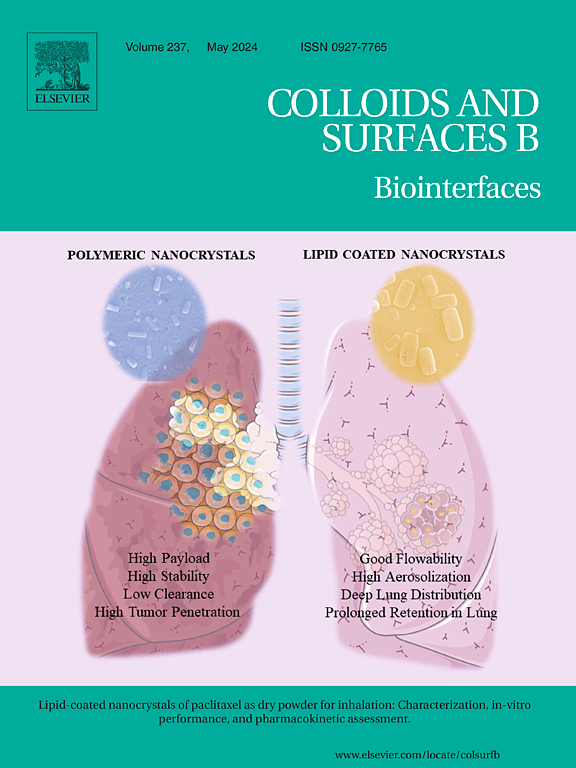Elevation and adhesion properties of injectable hydrogels based on catechol/boronic acid-modified Alaska pollock gelatin for endoscopic submucosal dissection
IF 5.6
2区 医学
Q1 BIOPHYSICS
引用次数: 0
Abstract
Elevation of early-stage gastrointestinal cancer using submucosal injection materials (SIMs) and postoperative wound care with adhesive materials are crucial for preventing complications arising from endoscopic submucosal dissection (ESD). Several types of SIMs have been developed; however, they often provide insufficient tissue elevation and fail to adequately adhere to the defect following the removal of early-stage gastrointestinal cancer. In this study, we present the development of injectable Cat-PBA-ApGltn hydrogels, which are based on catechol group-modified Alaska pollock gelatin (Cat-ApGltn) and phenylboronic acid-modified Alaska pollock gelatin (PBA-ApGltn), serving as multifunctional SIMs. A Cat-ApGltn/PBA-ApGltn mixed solution formed a hydrogel within 3 seconds. The resulting Cat-PBA-ApGltn hydrogels were easily injected manually through a 23 G needle due to their shear-thinning properties. Additionally, 10 w/v% Cat-PBA-ApGltn hydrogels demonstrated a 2.3-fold increase in mucosal elevation (7.2 ± 0.4 mm) compared with a commercially available SIM (3.1 ± 0.7 mm). The 10 w/v% Cat-PBA-ApGltn hydrogel, when adhered to porcine gastric submucosa, exhibited a burst strength 7 times greater than the average human intragastric pressure. Furthermore, the Cat-PBA-ApGltn hydrogels demonstrated biodegradability without inducing severe inflammation upon implantation in rat subcutaneous tissue. These Cat-PBA-ApGltn hydrogels hold promise as multifunctional SIMs, boasting injectability, excellent elevation, adhesion capabilities, and biodegradability.
基于邻苯二酚/硼酸改性阿拉斯加狭鳕明胶的可注射水凝胶在内窥镜粘膜下剥离中的提升和粘附特性
使用粘膜下注射材料(SIMs)抬高早期胃肠癌以及使用粘合材料进行术后伤口护理,对于预防内镜粘膜下剥离术(ESD)引起的并发症至关重要。目前已开发出多种类型的粘膜下注射材料,但它们在早期胃肠癌切除术后往往不能提供足够的组织隆起,也不能充分粘附在缺损处。在本研究中,我们开发了可注射的 Cat-PBA-ApGltn 水凝胶,它基于儿茶酚基团改性的阿拉斯加狭鳕明胶(Cat-ApGltn)和苯硼酸改性的阿拉斯加狭鳕明胶(PBA-ApGltn),可作为多功能 SIMs。Cat-ApGltn/PBA-ApGltn 混合溶液可在 3 秒内形成水凝胶。由于其剪切稀化特性,Cat-PBA-ApGltn 水凝胶很容易通过 23 G 的针头手动注射。此外,与市售的 SIM(3.1 ± 0.7 mm)相比,10 w/v% Cat-PBA-ApGltn 水凝胶的粘膜隆起(7.2 ± 0.4 mm)增加了 2.3 倍。当 10 w/v% Cat-PBA-ApGltn 水凝胶粘附到猪胃黏膜下层时,其爆破强度是人类平均胃内压的 7 倍。此外,Cat-PBA-ApGltn 水凝胶植入大鼠皮下组织后可生物降解,不会诱发严重炎症。这些Cat-PBA-ApGltn水凝胶有望成为多功能SIM,具有注射性、出色的隆起性、粘附能力和生物降解性。
本文章由计算机程序翻译,如有差异,请以英文原文为准。
求助全文
约1分钟内获得全文
求助全文
来源期刊

Colloids and Surfaces B: Biointerfaces
生物-材料科学:生物材料
CiteScore
11.10
自引率
3.40%
发文量
730
审稿时长
42 days
期刊介绍:
Colloids and Surfaces B: Biointerfaces is an international journal devoted to fundamental and applied research on colloid and interfacial phenomena in relation to systems of biological origin, having particular relevance to the medical, pharmaceutical, biotechnological, food and cosmetic fields.
Submissions that: (1) deal solely with biological phenomena and do not describe the physico-chemical or colloid-chemical background and/or mechanism of the phenomena, and (2) deal solely with colloid/interfacial phenomena and do not have appropriate biological content or relevance, are outside the scope of the journal and will not be considered for publication.
The journal publishes regular research papers, reviews, short communications and invited perspective articles, called BioInterface Perspectives. The BioInterface Perspective provide researchers the opportunity to review their own work, as well as provide insight into the work of others that inspired and influenced the author. Regular articles should have a maximum total length of 6,000 words. In addition, a (combined) maximum of 8 normal-sized figures and/or tables is allowed (so for instance 3 tables and 5 figures). For multiple-panel figures each set of two panels equates to one figure. Short communications should not exceed half of the above. It is required to give on the article cover page a short statistical summary of the article listing the total number of words and tables/figures.
 求助内容:
求助内容: 应助结果提醒方式:
应助结果提醒方式:


